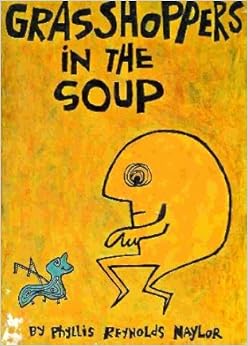In mid-October, I was lucky enough to be in the audience at one of my local libraries as Phyllis Reynolds Naylor kicked off her tour for the last Alice book, Now I’ll Tell You Everything. She mentioned in her remarks that she got her start as a short story author, and that her first book was a short story collection. Indeed, a little bit of Googling led me to the title of her first book, Grasshoppers in the Soup, which was published in 1965. This book is not widely available in my local libraries, but I was able to obtain a copy via inter-library loan.
The stories in Grasshoppers in the Soup are all about a group of teenagers, many of whom are members of the same youth group. Some stories are more overtly religious, involving pastors and church functions. Others have little to do with religion, and focus instead on issues like finding dates for special events, getting ready for work or college, impressing one’s classmates by hiding one’s true self, and interacting with overprotective parents. Each story, despite its main focus, has a humorous tone, and many of the stories end with a cute twist that leaves the reader smiling. One story, "P is for Principle", even manages to take on the issue of segregation as it applies to a restaurant where one young man has secured a job.
In some ways, there is a huge difference between these stories and Naylor’s writing in the Alice books. The teens in Grasshoppers in the Soup are neither angsty nor foul-mouthed. There is no discussion of sex, and often, stories with real moral dilemmas are left open-ended so the reader can discuss and resolve them, and the author does not have to provide a specific resolution. The Alice series is much more frank in its discussions of teen issues, and the tone is much less frivolous and much more contemporary. Still, though, one can see glimmers of Naylor’s future career in these stories. Alice attends a youth group. Alice has a large group of friends, many of whom pair off for dates or relationships throughout the series. Alice encounters discrimination, fights against her father’s rules, goes to camp, and has a first job. In all of her work for teens, it seems, Naylor is concerned with the day-to-day experiences kids have with their friends and with the milestones that make up the teen years. It is interesting to see how her interest in these things evolves and matures over time, but ultimately remains consistent.
It is also interesting to note that Naylor writes most of these short stories from the point of view of a male character. After reading so many books in Alice’s very obviously female voice, I enjoyed this change of pace and was impressed by how convincing her male narrators really are. On a related note, though, I will admit that it was difficult to keep track of the characters who recur throughout the story collection. Names like Ted, Chuck, and Marcia came up several times, but it was hard to tell whether they were just names for generic characters, or if I was meant to know these characters already from their involvement in previous stories. For the most part, I would say it is the plots that are significant to these stories, and not the characters, as most of them seemed very similar to one another, and more like vehicles for telling a story than people who grow and change significantly.
Grasshoppers in the Soup is very much a product of its time, and I don’t think many of the stories would ring true for today’s teens. That said, approached as an author study, reading this collection was very enlightening and gave me a new perspective on the many themes and topics that can provide good short story fodder, for a teen audience or any audience.


No comments:
Post a Comment